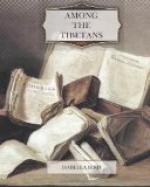Finally, I had a Cabul tent, 7 ft. 6 in. by 8 ft. 6 in., weighing, with poles and iron pins, 75 lbs., a trestle bed and cork mattress, a folding table and chair, and an Indian dhurrie as a carpet.
My servants had a tent 5 ft. 6 in. square, weighing only 10 lbs., which served as a shelter tent for me during the noonday halt. A kettle, copper pot, and frying pan, a few enamelled iron table equipments, bedding, clothing, working and sketching materials, completed my outfit. The servants carried wadded quilts for beds and bedding, and their own cooking utensils, unwillingness to use those belonging to a Christian being nearly the last rag of religion which they retained. The only stores I carried were tea, a quantity of Edwards’ desiccated soup, and a little saccharin. The ‘house,’ furniture, clothing, &c., were a light load for three mules, engaged at a shilling a day each, including the muleteer. Sheep, coarse flour, milk, and barley were procurable at very moderate prices on the road.
Leh, the capital of Ladakh or Lesser Tibet, is nineteen marches from Srinagar, but I occupied twenty-six days on the journey, and made the first ‘march’ by water, taking my house-boat to Ganderbal, a few hours from Srinagar, via the Mar Nullah and Anchar Lake. Never had this Venice of the Himalayas, with a broad rushing river for its high street and winding canals for its back streets, looked so entrancingly beautiful as in the slant sunshine of the late June afternoon. The light fell brightly on the river at the Residency stairs where I embarked, on perindas and state barges, with their painted arabesques, gay canopies, and ‘banks’ of thirty and forty crimson-clad, blue-turbaned, paddling men; on the gay facade and gold-domed temple of the Maharajah’s Palace, on the massive deodar bridges which for centuries have defied decay and the fierce flood of the Jhelum, and on the quaintly picturesque wooden architecture and carved brown lattice fronts of the houses along the swirling waterway, and glanced mirthfully through the dense leafage of the superb planes which overhang the dark-green water. But the mercury was 92 degrees in the shade and the sun-blaze terrific, and it was a relief when the boat swung round a corner, and left the stir of the broad, rapid Jhelum for a still, narrow, and sharply winding canal, which intersects a part of Srinagar lying between the Jhelum and the hill-crowning fort of Hari Parbat. There the shadows were deep, and chance lights alone fell on the red dresses of the women at the ghats, and on the shaven, shiny heads of hundreds of amphibious boys who were swimming and aquatically romping in the canal, which is at once the sewer and the water supply of the district.




